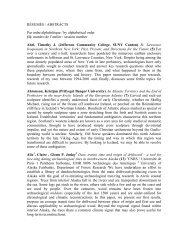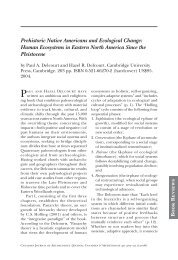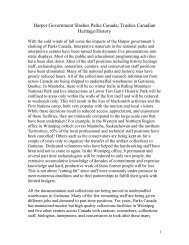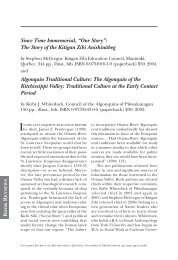16 - 20 MAI MAY 16 - 20 - Canadian Archaeological Association
16 - 20 MAI MAY 16 - 20 - Canadian Archaeological Association
16 - 20 MAI MAY 16 - 20 - Canadian Archaeological Association
You also want an ePaper? Increase the reach of your titles
YUMPU automatically turns print PDFs into web optimized ePapers that Google loves.
and ethnic variations reflected in them. Five sites, will be compared:<br />
Draper and Keffer-late pre-contract Huron villages; Roebuck and<br />
McKeown - late pre-contact St. Lawrence Iroquoian villages; and<br />
Steward, a stratified St. Lawrence Iroquoian fishing station.<br />
Jamieson, Susan M. (Trent University) • Rethinking Trigger’s Wendat<br />
Socio-Political Model [23]<br />
Bruce Trigger’s Wendat socio-political construct continues to be<br />
widely cited and generally accepted as fact by archaeologists working<br />
in southern Ontario. However, Trigger’s underlying assumptions of<br />
Northern Iroquoian homogeneity and neo-evolutionary understandings<br />
of such concepts as `egalitarianism’ and `hierarchy’ limit questions<br />
asked of the archaeological record and cause us to uncritically<br />
dismiss historical documents. Similarly, our archaeological interpretations<br />
are constrained by his predominantly rationalist interpretations<br />
for trade items. I conclude that approaches of the sort termed<br />
`romantic’ by Trigger provide a means to address intensified group<br />
ritual, especially as expressed by the Feast of Souls/Feast of the Dead<br />
and its associated feasting and gifting. In turn, they allow us to more<br />
forcefully interpret networks of social obligation and agencies of<br />
cultural transformation that resulted in varying degrees of political<br />
centralization in southern Ontario during the late sixteenth and early<br />
seventeenth centuries.<br />
Jenkinson, Anthony, Richard Nuna and Stephen Loring • An “Archaic”<br />
boat building site at Kamestastin [18]<br />
Since 1999 Tshikapisk Foundation, (an organization promoting Innu<br />
experiential education and historical and archaeological research)<br />
has pursued archaeological work in the tundra regions of Northern<br />
Labrador and adjacent Northern Quebec. This region is the homeland<br />
of the Mushuau Innuts, the People of the Tundra, the northern<br />
most group of Innu. So far this research has discovered over 260 sites<br />
(143 of these dating from the pre-contact era) including occupations<br />
from all recognized archaeological periods in the region, from about<br />
7000 BP to the present. Unique among the pre-contact sites in the<br />
Kamestastin region is the Kaniuekutat site (GlCs-15.) This paper will<br />
describe the characteristics and discuss the significance of what appears<br />
to be an archaic era canoe building site with an assemblage<br />
consisting entirely of quartz and slate.<br />
Un site de construction de canoe de la période Archaïque à Kamestastin<br />
Depuis 1999 la Fondation de Tshikapisk, (une organisation vouée à la<br />
promotion de l’apprentissage innu expérientielle dans le domaine de<br />
la recherche historique et archéologique) réalise des recherches dans<br />
la toundra du Labrador et du Nord du Québec. Cette région est occupée<br />
par les Mushuau Innuts, les Gens de la Toundra, le groupe innu le<br />
plus septentrional. À ce jour, ces recherches ont permis d’enregistrer<br />
plus de 260 sites (dont 143 datent de la période pré-contact) associés<br />
à toutes les périodes archéologiques reconnues dans la région, depuis<br />
7000 ans BP à aujourd’hui. Parmi ceux-ci, le site Kaniuekutat (GlCs-<br />
15), dans la région Kamestastin, est unique. Cette conférence décrira<br />
les caractéristiques de ce site et discutera de la signification de ce qui,<br />
vraisemblablement, s’apparente à un site de fabrication de canoë de<br />
la période archaïque, dont l’assemblage lithique se compose entièrement<br />
de quartz et d’ardoise.<br />
Jennings 1 , Cecilia, Andre Robichaud 2 , James M. Erhman 3 , and Colin<br />
P. Laroque 1 ( 1 Mount Allison University; 2 Université de Moncton,<br />
campus de Shippagan; 3 Digital Microscopy Facility, Mount<br />
Allison University) • Odes of Joy, or Sounds of Silence? How do you<br />
sample a “priceless” artifact? [13]<br />
Antonio Stradivari’s violins are famous around the world for their superior<br />
quality and incredible cultural and financial value, but only a<br />
fraction of authentic Stradivari survive today, making them a common<br />
subject of replication. The MAD Lab received an old violin from a client,<br />
with a label claiming it had been built by Stradivarius in 1734. In<br />
order to determine whether or not this violin was a fake, the wood of<br />
the violin had to be dated, since any growth past 1734 would prove<br />
the instrument false. We relied on traditional dendroarchaeological<br />
methods, but in order to ensure there was no damage to a potentially<br />
priceless instrument, we also used new applications of a replication<br />
polymer technology in conjunction with a scanning electron microscope,<br />
as we tried to trace the violin’s wood back to its origins and<br />
discover when and where it was made.<br />
Keron, James (University of Western Ontario) • Archaeology and<br />
Spatial Statistics [3]<br />
This paper presents the history and intellectual traditions of spatial<br />
statistics in archaeology, discusses some of the methodological problems<br />
and reviews the tools available to assist the archeologist in conducting<br />
this form of analysis. Thirty-five years ago a focus of processual<br />
archaeology was the application of spatial statistics. After 1990,<br />
with the advent of the post processual approach, emphasis waned<br />
and, in the more extreme forms, was simply rejected altogether. Despite<br />
this shift, some focus has been maintained and advances have<br />
been made in other areas of the academy. The spatial nature of most<br />
archaeological material imposes constraints on statistical analysis in<br />
that it violates one of the conditions for application of traditional statistics<br />
- homogeneity. Familiarity with the nature and applicability<br />
of spatial statistics is critical to valid statistical analysis. Fortunately,<br />
there are a number of statistical packages available which implement<br />
the more common methods.<br />
Kitchel, Nathanial (University of Wyoming) • The Newest of Worlds:<br />
Quarries as Proxy Measures of Landscape Learning in the Pleistocene<br />
Northeast [2]<br />
Quarries and toolstone acquisition areas of fined grained siliceous<br />
materials provide fixed points on the landscape with particular importance<br />
to prehistoric populations. Despite the occurrence of a constellation<br />
of lithic raw materials during the Paleoindian period, questions<br />
remain about the rapidity with which these early populations<br />
acquired knowledge of tool stone sources. It is also unclear whether<br />
the acquisition of this knowledge is archaeologically visible. In this<br />
study the presence or absence of various raw materials in early and<br />
middle fluted point sites from northeastern North America is used<br />
to investigate changes in toolstone use between earlier and later Paleoindian<br />
populations. These differences may help us understand the<br />
process of landscape learning and other phenomenon associated with<br />
the colonization of uninhabited landscapes. This study will evaluate<br />
different models of colonization and how quickly stone quarries and<br />
tool stone sources became places of lasting importance throughout<br />
prehistory.<br />
Kolhatkar, Manek (Université de Montréal) • Loosening the bonds<br />
of technical practice: the chaîne opératoire as a flawed metaphor [25]<br />
For the past half-century, the chaîne opératoire approach has allowed<br />
its practitioners to gain a better understanding of the technical practices<br />
of people, through the belief that form should not preclude the<br />
deeper structural explanation of such practices. In this regard, the<br />
chaîne opératoire can be understood as a metaphor as to how we<br />
should link gestures together, that is, a sequential but linear, programmatic<br />
as well as ultimately homogenizing reconstruction and<br />
understanding of technical activities. Here, through my analysis of the<br />
manufacture of projectile points that occurred at the Late Paleoindian<br />
site of La Martre (Gaspe peninsula, Quebec), I will show that such an<br />
approach is useful but insufficient for it brings one to confuse the different<br />
logical links that happen at various scales of technical practice,<br />
where the craftsman and the social group end up being considered<br />
as the same person. Other, more complex metaphors, could be used<br />
so as to make more room for the variability that archaeologists try to<br />
describe with increasing levels of details.<br />
Les failles de la chaîne opératoire, et la libération de la pratique technique<br />
Depuis les années 60, l’approche de type chaîne opératoire a permis<br />
aux archéologues d’acquérir une meilleure connaissance des pratiques<br />
techniques des populations étudiées, au travers d’une analyse<br />
structurelle plutôt que formelle de telles pratiques. La chaîne opératoire<br />
peut ainsi être comprise comme une métaphore permettant de<br />
lier les gestes techniques de façon séquentielle, mais aussi linéaire,<br />
prédéterminée et homogénéisée. Mes analyses de la fabrication de<br />
pointes de projectiles qui ont eu lieu sur le site paléoindien récent<br />
de La Martre (Gaspésie, Québec) montrent qu’une telle approche est<br />
utile mais insuffisante car elle ne fait pas suffisamment la distinction<br />
entre les différents liens logiques qui se manifestent dans les multiples<br />
échelles de la pratique technique. D’autres métaphores plus<br />
complexes pourraient être utilisées de telle sorte que la variabilité<br />
dont les archéologues tentent de rendre compte puisse s’exprimer<br />
avec moins de restrictions.<br />
46








